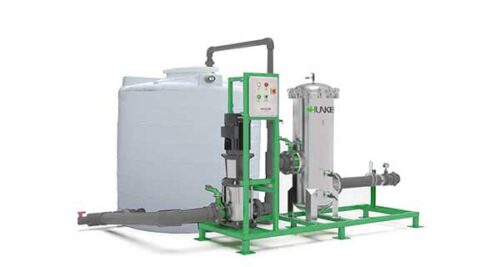Membrane Cleaning CIP Systems

In normal operation, the membrane in reverse osmosis elements can become fouled and scaled by suspended solids, microorganisms, and minerals. Membrane cleaning CIP Systems help to remove these deposits build up during operation and cause loss in water output or salt rejection, or both. Regular cleaning of the membrane elements minimizes the loss of performance and extends membrane life.
Membrane cleaning systems are designed to be used with any RO system to clean membranes without removing them from the system. Our cleaning systems are with hoses and quick disconnect fittings to allow easy connection to the membrane system.
Membrane Cleaning CIP Skid System
Dosing Chemical: Automatic
Including: Skid, pump, cartridge filter housing, PE storage tank, dosing pump and tank
Level Switch: Optional
Control: Manual or automatic
What is membrane cleaning CIP systems?
After using system for a while, membranes become dirty and clogged with all types of fouling occurrences such as colloidal, organic, inorganic, and biological materials creating a need for cleaning. Our membrane cleaning CIP system cleanses the membranes and extends the lifespan by double or even triple the normal lifespan. Thus, CIP means that clean-in-place.
Fouling is the main culprit that causes membranes to stop working properly. For this reason, the following features highlight the useful ways. In which membrane cleaning systems improve the performance, reliability, and durability of RO, UF membrane technology. Consider the following information as important questions you will need to ask a producer before choosing the correct CIP system.
- Cartridge filter: block organic matter discharged from the membranes
- Cleaning pump: spreads the cleansing mixture throughout the RO membranes
- Tank: enables blending of the cleaning solution
- Control panel: to control operating the system in auto or manual mode
- Level switch: to protect the cleaning pump from running dry
When do i clean ro membranes?
When operating under normal conditions, the reverse osmosis membranes can become dirty and covered by micropollutants, organic material, and suspended solids. These sediments accumulate during use and trigger a reduction in the output of water, salt rejection, or both. Membrane components are required to be cleaned once the standardized saturate water output lowers by at least 10% from its original flow rate, which is the flow rate recognized in the first 48 hours of use. Other instances that may indicate a need for cleaning is when the salt passage in the feed water rises by more than 10%, or when the membrane pressure drops by at least 10% as well. So, this is a common occurrence and demonstrates membrane fouling.
It is also important to understand that the water output rate will inevitably be reduced if the feed water temperature decreases.

